Azure File Share vs Blob

Azure offers two main storage options for businesses: Azure File Share and Azure Blob Storage. These cloud-based solutions help companies store and manage their data efficiently.
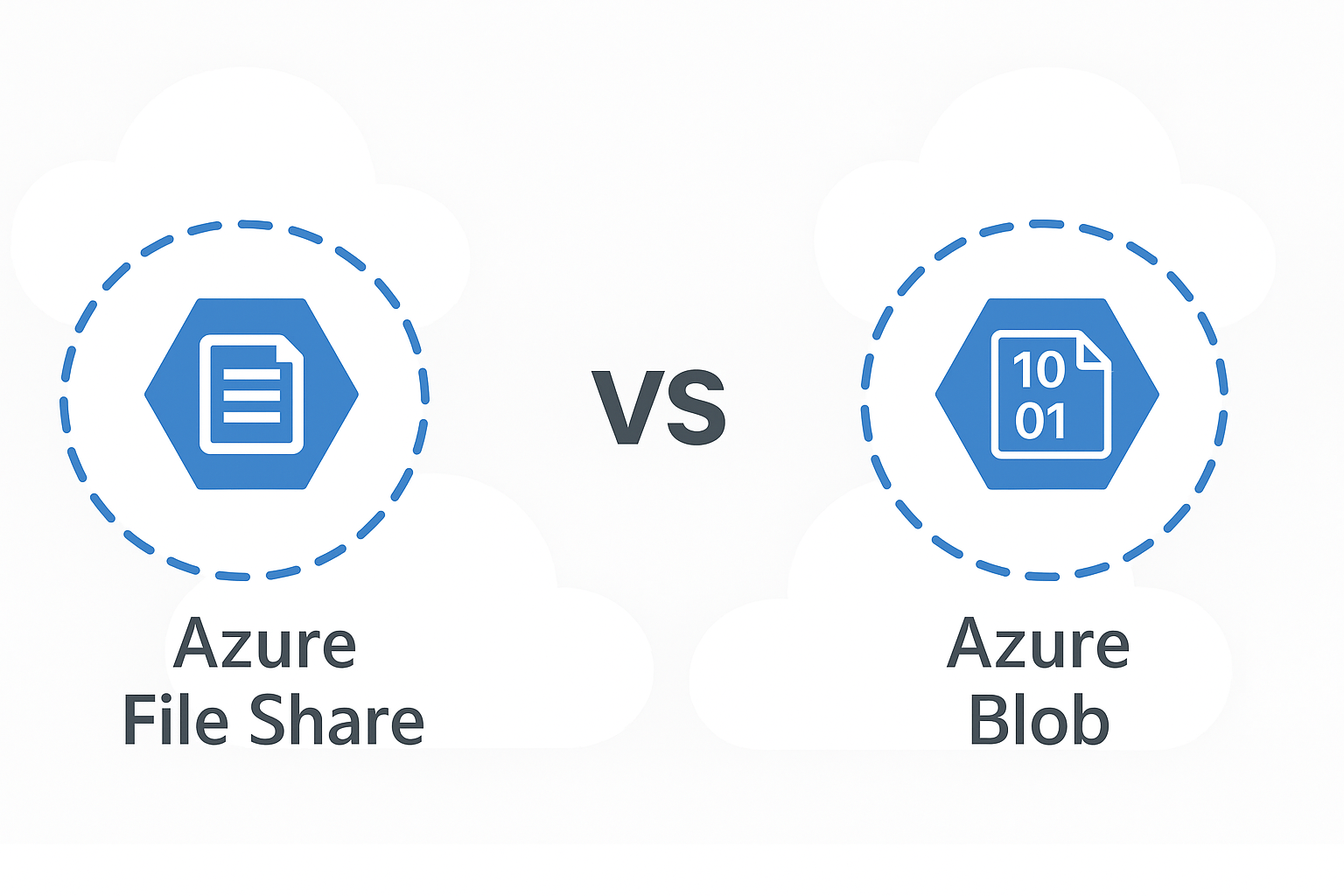
Azure File Share works like a regular network drive. It lets users access files from anywhere using standard file sharing protocols. Azure File Share is best for applications that need file system support and shared access to files. This makes it a good choice for replacing on-premises file servers.
Azure Blob Storage, on the other hand, is designed for storing large amounts of unstructured data. It’s ideal for storing things like images, videos, and backups. Blob Storage is cheaper and can handle bigger files than File Share. Companies often use it to build data lakes for analytics or to store data for web and mobile apps. With the addition of Hierarchical Namespace Files can be stored with granular permissions integrated with Entra ID.
Overview of Azure Storage Services
<iframe width="560" height="315" src="https://www.youtube.com/embed/UzTtastcBsk?si=G6RlOKnYRTYOAQwF" title="YouTube video player" frameborder="0" allow="accelerometer; autoplay; clipboard-write; encrypted-media; gyroscope; picture-in-picture; web-share" referrerpolicy="strict-origin-when-cross-origin" allowfullscreen>
Azure Storage offers different services to handle various data types and access needs. These services cater to both structured and unstructured data in the cloud.
Understanding Azure Blob Storage
Azure Blob Storage is designed for storing large amounts of unstructured data. It’s ideal for:
- Storing files, videos, and images
- Serving content directly to browsers
- Backing up data and systems
- Analyzing big data sets
Blob Storage organizes data into containers, similar to folders. Each container can hold multiple blobs (files). This structure allows for easy management and access control.
Blobs come in three types:
- Block blobs for text and binary files
- Append blobs for log files
- Page blobs for frequent read/write operations
Azure Blob Storage supports tiered storage options. These tiers help balance cost and access speed based on data usage patterns.
Understanding Azure File Share
Azure File Share provides fully managed file shares in the cloud. It uses the Server Message Block (SMB) protocol, making it compatible with Windows, Linux, and macOS.
Key features of Azure File Share include:
- Shared access across multiple VMs
- Use of familiar file system APIs
- Support for both cloud and on-premises access
File shares work well for:
- Replacing or supplementing on-premises file servers
- Storing config files for cloud apps
- Sharing diagnostic data
Azure File Shares can be mounted simultaneously by cloud and on-premises deployments. This feature enables seamless data migration and hybrid scenarios.
File Share supports two performance tiers: standard and premium. The choice depends on the required IOPS and throughput.
Key Differences Between Azure File Share and Blob Storage
Azure File Share and Blob Storage offer distinct storage solutions with unique features and use cases. Their differences span data structure, access methods, performance, and cost considerations.
Structure and Usage
Azure File Share provides a fully managed file system in the cloud. It stores data as files and folders, similar to traditional file servers. This structure makes it ideal for applications that require a hierarchical organization.
Blob Storage, on the other hand, is designed for unstructured data. It stores data as objects, making it suitable for large-scale data storage like backups, media files, and data lakes. With the addition of Hierarchical Namespace Files can be stored with granular permissions integrated with Entra ID – mirroring Azure File Share capabilities without requiring the overhead of SMB or Active Directory.
Access Protocols
File Share supports the Server Message Block (SMB) protocol. This allows for easy integration with Windows-based systems and applications. It can be mounted as a network drive, providing a familiar interface for users and applications.
Blob Storage is accessible via REST APIs. This makes it versatile for various applications and platforms. It’s particularly useful for web and mobile applications that need to store and retrieve large amounts of data.
Performance Considerations
File Share offers good performance for general file storage and sharing needs. It’s suitable for scenarios requiring frequent random access to files. File Share also supports caching through Azure File Sync, improving performance for geographically distributed access. File Shares can be accessed with SMB and integrated into Active Directory which adds additional overhead typically necessitating higher storage tiers.
Blob Storage excels in scenarios involving large-scale data ingestion and retrieval. It’s optimized for high-throughput operations, making it ideal for File Sharing, big data analytics, content delivery, and backup solutions.
Pricing Models
File Share pricing is based on the amount of data stored and the number of transactions. It offers standard and premium tiers, with premium providing higher performance for I/O-intensive workloads.
Blob Storage pricing varies by access tier and redundancy options. The hot tier is priced higher for storage but lower for access, while the cool and archive tiers offer cheaper storage at the cost of higher access fees. This model allows for cost optimization based on data access patterns.
Deployment Scenarios
Azure File Share and Blob Storage offer distinct advantages for different deployment scenarios. Each solution caters to specific needs in cloud storage and file management.
Leveraging Azure File Share for Lift and Shift
Azure File Share excels in lift and shift migrations. It provides a familiar file system structure, making it ideal for organizations transitioning existing applications to the cloud. Azure File Share supports SMB protocol, allowing easy mounting on Windows, Linux, and macOS systems.
For companies looking to move their file servers to Azure, Azure File Share offers a seamless solution. It maintains compatibility with legacy applications that rely on file system APIs. This approach minimizes code changes and reduces migration complexity.
Azure File Share also supports hybrid deployments. Teams can use Azure File Sync to cache frequently accessed files on-premises while keeping the main dataset in the cloud. This setup improves performance for local users while providing cloud benefits.
Using Blob Storage for Cloud-Native Applications
Blob Storage is optimal for cloud-native applications and large-scale data storage. It offers superior scalability and performance for unstructured data like images, videos, and logs. Blob Storage integrates well with analytics services, making it suitable for big data workloads.
Developers can easily incorporate Blob Storage into their applications using REST APIs. This makes it a go-to choice for building modern, cloud-based solutions. Blob Storage also provides tiered storage options, allowing cost-effective management of data based on access frequency.
For enterprises developing new cloud applications, Blob Storage offers robust features like data lifecycle management and strong consistency. It supports various data types and sizes, making it versatile for diverse application needs.
Data Management and Accessibility
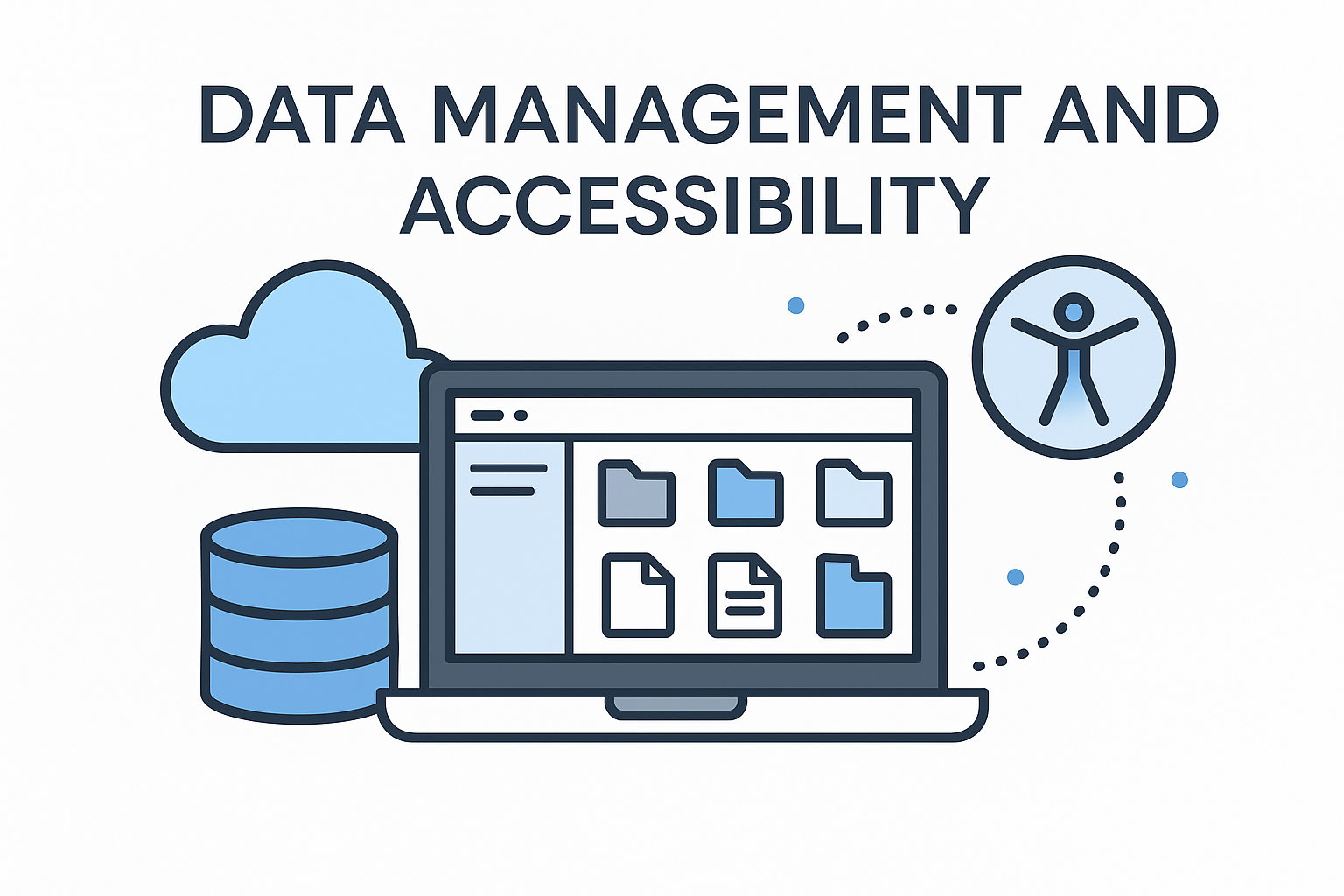
Azure File Share and Blob offer different approaches to managing and accessing data in the cloud. Each option has unique features for uploading, synchronizing, and managing files across distributed environments.
Uploading Data to Azure File Share and Blob
Azure File Share allows users to upload data through familiar methods. Files can be added using standard file explorer interfaces or command-line tools. For Blob storage, data uploads typically involve using APIs or specialized tools.
The Azure Storage Explorer provides a user-friendly interface for managing both File Share and Blob data. It lets users drag and drop files, create folders, and set permissions easily.
Azure CLI offers a command-line option for uploading to both services. It’s useful for automating data transfers and integrating with scripts.
Distributed Access and File Synchronization
Azure File Share excels in providing distributed access to files. It supports SMB protocol, allowing easy mounting on Windows, macOS, and Linux systems.
Azure File Sync enhances File Share by enabling caching of frequently accessed files on local servers. This reduces latency for remote users while maintaining centralized storage in Azure.
Blob storage focuses on scalable object storage. It’s ideal for large datasets accessed by applications rather than individual users.
Both services support role-based access control (RBAC) for managing permissions across large organizations.
Tools for Data Management
The Azure Portal offers a web-based interface for managing File Share and Blob storage. Users can create containers, set access policies, and monitor usage.
Azure Storage Explorer provides a desktop application for advanced management tasks. It allows users to work with multiple storage accounts and services.
PowerShell cmdlets enable administrators to automate management tasks for both File Share and Blob storage. These tools are particularly useful for bulk operations and scripting.
AzCopy is a command-line utility optimized for high-performance data transfers to and from Azure storage services. It supports both File Share and Blob storage.
Security and Compliance

Azure File Share and Blob Storage offer strong security features and meet key compliance standards. Both use encryption and access controls to protect data. They also follow important rules for data handling.
Encryption and Secure Access
Azure File Share and Blob Storage use encryption at rest and in transit. This keeps data safe when stored and when moving between systems.
For access control, both services use Shared Access Signatures (SAS). SAS tokens allow limited, time-bound access to resources. This helps prevent unauthorized use.
Azure Storage Accounts also support Microsoft Entra ID for authentication. This method is safer than using shared keys. It follows the least privilege principle, giving users only the access they need.
Azure File Shares permit SAS tokens at the file share level, whereas Azure Blob Storage with Data Lake and Hierarchical NameSpace permit them at the file and folder level greatly enhancing granular permissions and file/folder sharing capabilities.
Compliance Standards and Certifications
Azure Storage services, including File Share and Blob, meet many compliance standards. These cover areas like:
- Data privacy
- Financial services
- Healthcare
- Government use
Some key certifications include:
- HIPAA
- PCI DSS
- ISO 27001
- SOC 1, 2, and 3
These certifications help businesses meet legal and industry requirements. They show that Azure takes data protection seriously.
Azure also offers tools to help customers stay compliant. These include audit logs and data retention policies.
Backup, Recovery, and Archiving
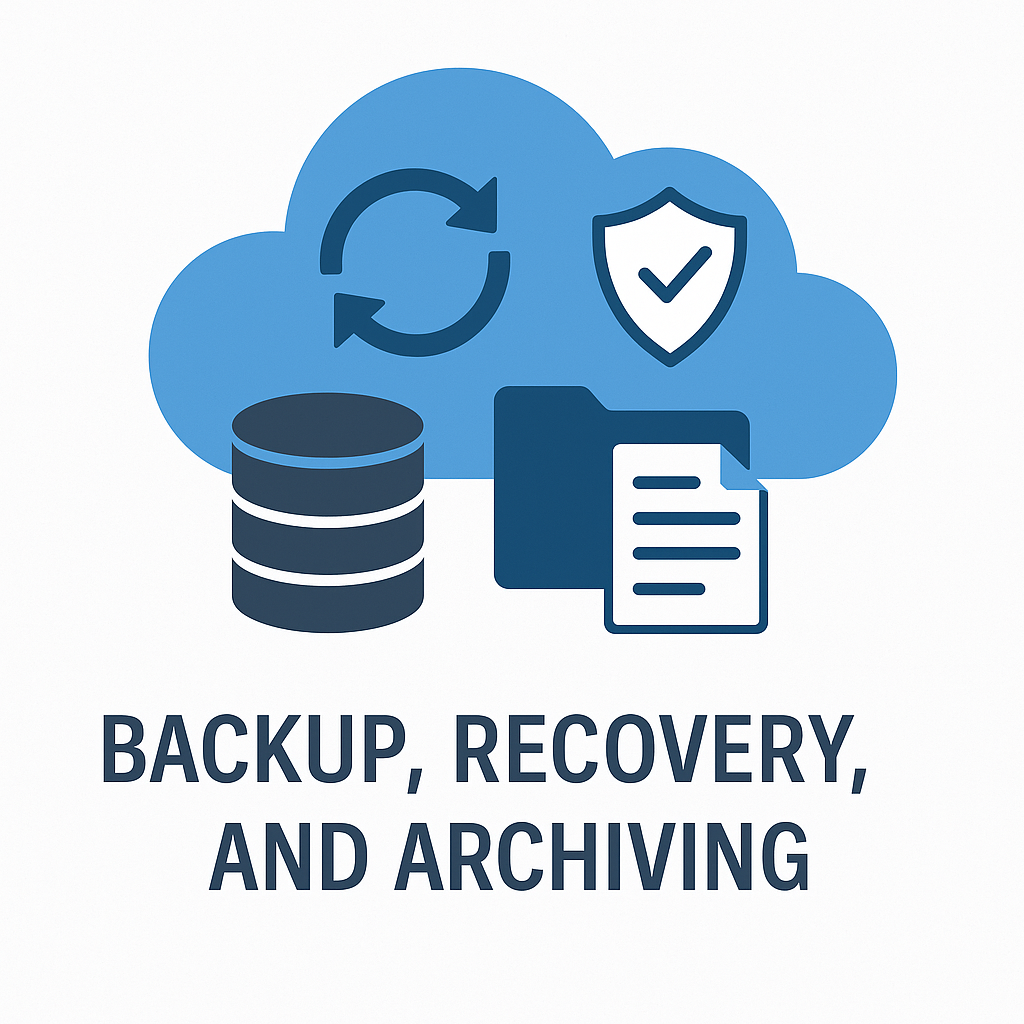
Azure File Share and Blob Storage offer robust options for data protection and long-term retention. Both services provide built-in capabilities to safeguard your information and recover it when needed.
Backup Strategies for File Share and Blob Storage
Azure File Share backup uses a cloud-based solution that protects data without extra on-premises overhead. It works smoothly with Azure File Sync to centralize file share data and backups.
For Azure Blob Storage, the backup service allows restoring data from any point where a recovery point exists. This feature is available as long as the data falls within the backup policy’s retention period.
Key backup features for both services include:
- Automated backups
- Customizable retention periods
- Point-in-time recovery
- Geo-redundant storage options
Disaster Recovery Options
Both Azure File Share and Blob Storage support geo-redundant storage for disaster recovery. This replicates data to a secondary region, ensuring availability during regional outages.
For File Shares, Azure File Sync can cache data on Windows Servers. This provides fast access near where the data is used, improving disaster recovery capabilities.
Blob Storage offers cross-region restore for some vault types. This allows data recovery in paired regions during failures.
Archiving Unstructured Data
Azure Blob Storage excels at archiving unstructured data. It offers tiered storage options:
- Hot tier: Frequently accessed data
- Cool tier: Infrequently accessed data
- Archive tier: Rarely accessed data
The archive tier provides the lowest storage costs but has higher retrieval fees and latency. It’s ideal for long-term data retention and compliance needs.
File Shares don’t offer a built-in archive tier. For archiving file share data, consider moving it to Blob Storage’s archive tier for cost-effective long-term storage.
Integrations and Advanced Features
Azure File Share and Blob Storage offer powerful integrations and advanced features. These enhance security, performance, and usability across different Azure services.
Integrating with Azure AD and VMs
Azure File Share works with Azure Active Directory (Azure AD) for identity-based access control. This lets admins set up secure access to file shares. Users can log in with their Azure AD credentials.
File shares can be mounted on Azure Virtual Machines (VMs) as network drives. This makes them easy to use like local storage. VMs can access files directly without copying data.
Active Directory Domain Services (AD DS) integration is also possible. This allows on-premises AD users to access Azure file shares. It’s great for hybrid setups.
Azure Blob Storage can be accesses over API using Entra ID with Hierarchical Namepace for identity-based access control. Users can login using their Native Entra ID credentials using products like MyWorkDrive.
Advanced Configuration for Optimized Performance
Azure File Share and Blob Storage have settings to boost performance. File shares support SMB multichannel. This uses multiple network connections to increase speed and reliability.
For Blob Storage, you can set up hierarchical namespaces. This improves performance for big data analytics workloads.
Both services offer tiering options. Hot access tiers are for frequently used data. Cool and Archive tiers save money on less-accessed data.
Azure File Sync helps cache file share data on local servers. This cuts down on latency for users far from Azure data centers.
Use Cases: File Share vs. Blob Storage
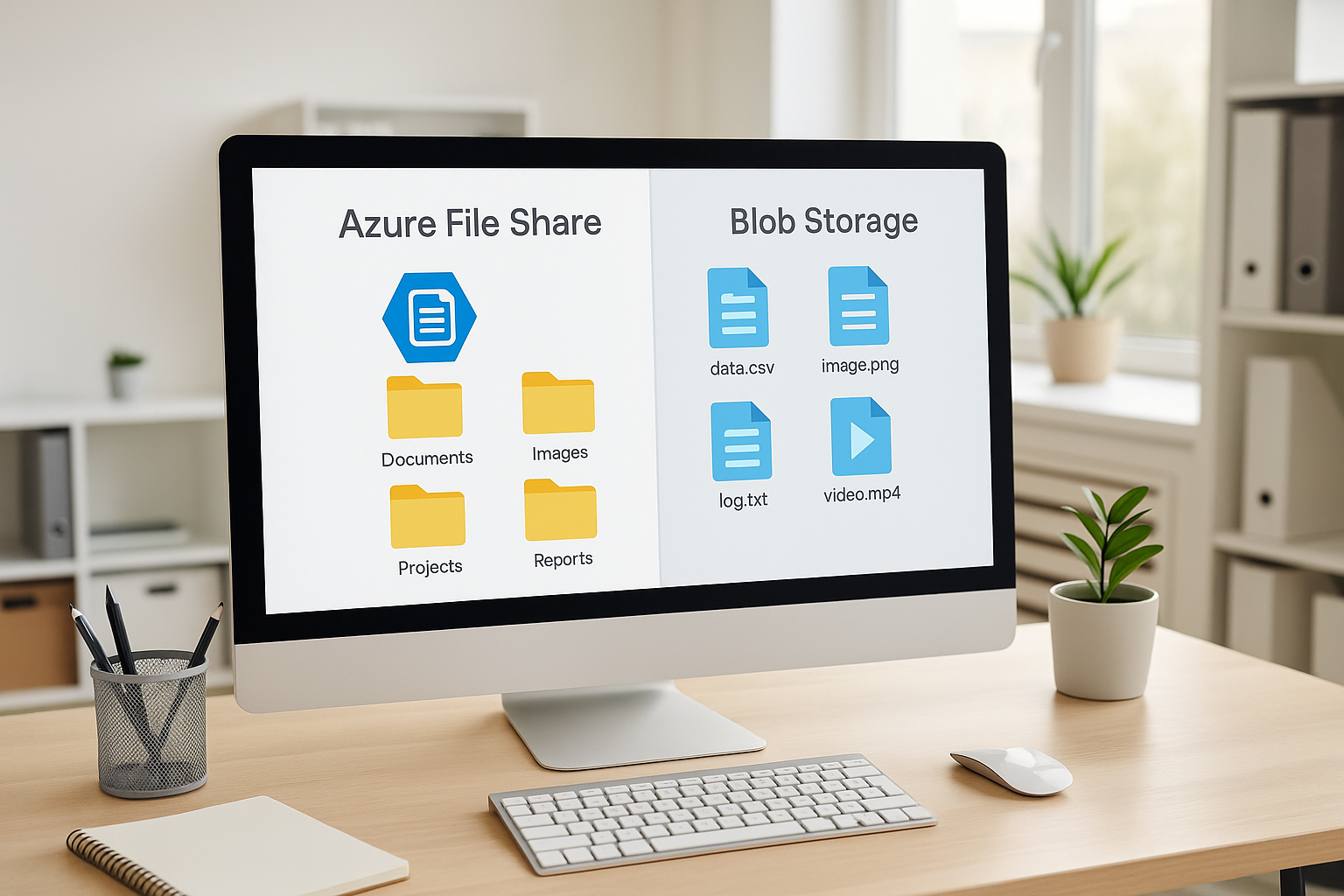
Azure File Share and Azure Blob Storage serve different needs. File Share works like a network drive, while Blob Storage handles large amounts of unstructured data.
Case Studies for Azure File Share
Azure File Share helps businesses that need shared file access. A marketing firm used it to store and share design files among teams in different offices. This setup allowed easy collaboration without the need for a physical server.
An IT company replaced its on-site file servers with Azure File Share. This move cut hardware costs and improved file access for remote workers. The firm could mount the shares directly, making the transition smooth for employees.
A software development company used Azure File Share to store build artifacts. This choice sped up their CI/CD pipeline by providing fast, shared access to files across build servers.
Case Studies for Azure Blob Storage
Azure Blob Storage excels at handling large amounts of unstructured data. A media company used it to store and stream video content to users worldwide. The scalability of Blob Storage allowed them to handle traffic spikes during popular events.
An e-commerce site stored product images in Blob Storage. This choice improved page load times and reduced the load on their main servers. The company could easily manage millions of images without performance issues.
A data analytics firm used Blob Storage to create a data lake. They stored vast amounts of raw data from various sources. This setup allowed them to run complex analyses and machine learning models on the data efficiently.
Optimizing Costs and Performance
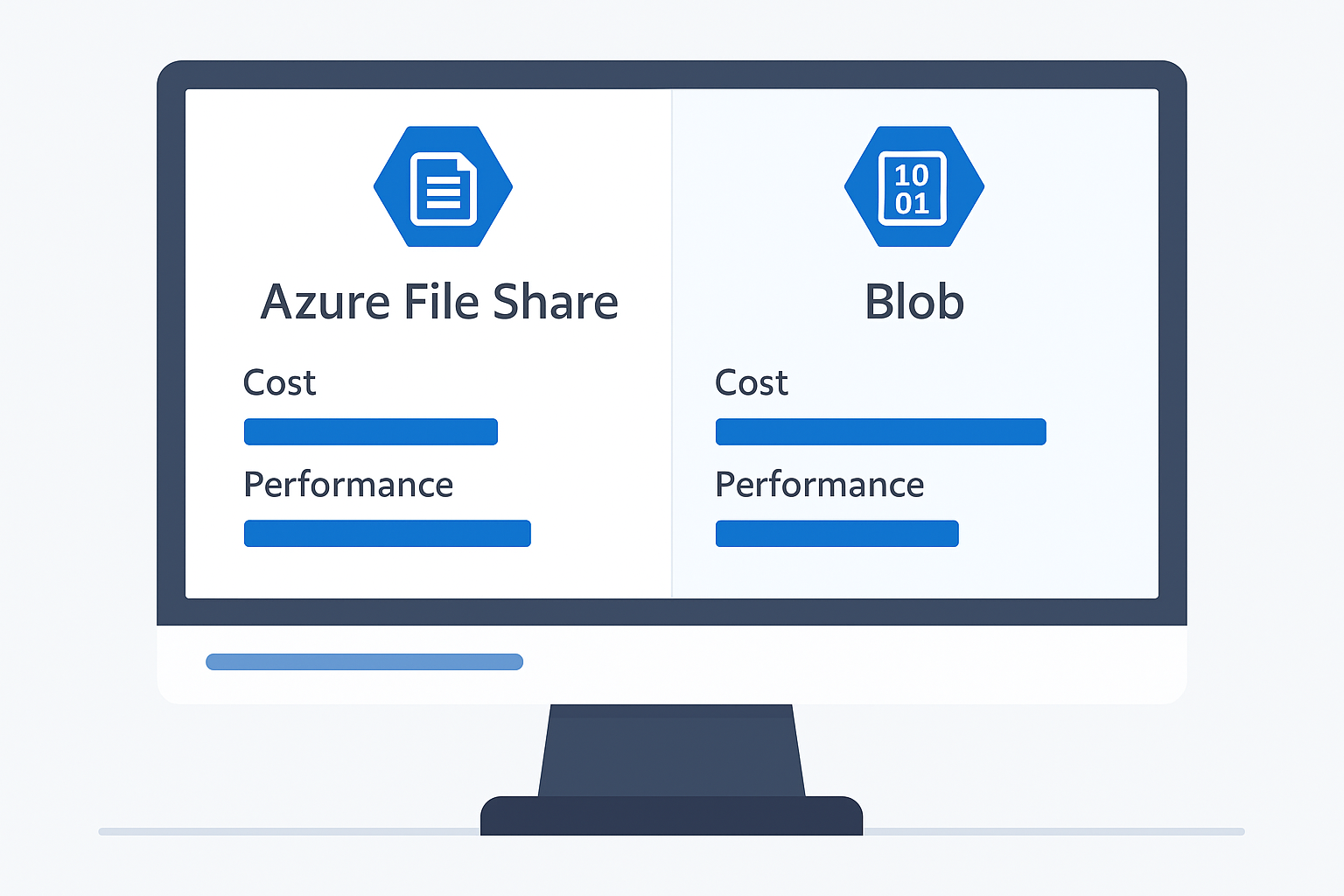
Azure File Share and Blob storage offer ways to cut costs and boost performance. Smart choices in storage tiers and close tracking of usage can lead to big savings. At the same time, tweaks to settings and design can speed things up.
Implementing Cost-Effective Storage Solutions
Azure provides different storage tiers to fit various needs and budgets. For less active data, cool or archive tiers can save money. These tiers cost less but have higher access fees.
Users should pick the right tier based on how often they need the data. For instance, rarely used files can go in the archive tier. This cuts storage costs a lot.
Another cost-saving tip is to use Azure File Sync. It lets users keep files on-site and in the cloud. This setup can reduce the need for pricey cloud storage.
Regular checks of storage use help spot waste. Users can set up alerts in Azure Cost Management to watch spending.
Monitoring and Enhancing Performance
To boost speed, users should put their storage account in the same region as their app. This cuts down on network delays.
For File Shares, SMB Multichannel can help. It uses multiple network connections to speed up data transfer. This works best when moving many files at once.
Blob storage users can gain from the CDN integration. It caches data closer to users, making access faster.
Both File Share and Blob benefit from using SSD-based Premium tiers for high-speed needs. While pricier, they offer much better performance for critical workloads.
Keeping an eye on metrics like latency and throughput is key. Azure provides tools to track these. Users can then make informed choices to improve speed.
Frequently Asked Questions
Azure File Share and Blob Storage have key differences in costs, performance, features, and use cases. These questions address common points of confusion between the two storage options.
What are the cost differences between Azure File Share and Blob Storage?
Azure Blob Storage is generally cheaper for large amounts of data. File Share costs more but offers additional features like SMB access. Blob Storage pricing depends on the access tier chosen. File Share pricing varies based on the redundancy level selected..
How does performance compare between Azure File Share and Azure Blob Storage?
Blob Storage typically offers higher throughput for large file operations. File Share supports SMB multichannel for improved performance when accessing from multiple clients simultaneously.
In which scenarios is Azure Blob Storage preferred over File Storage?
Blob Storage with Hierarchical Namespace provides Entra ID identity based Permissioning at the file and folder level without requiring active directory or SMB file sharing protocol. Blob Storage works best for big data analytics and storing large amounts of unstructured data. It's ideal for backups, archives, and media files. Blob Storage also suits applications that need to access data via REST APIs.
What distinct features do Azure File Shares offer compared to Azure Blob Storage?
Azure File Shares support SMB and NFS protocols, allowing easy mounting on Windows, Linux, and macOS systems. File Shares can be synced with on-premises servers using Azure File Sync for faster local access or migration.
Can you explain the main differences between Azure File Storage and Disk Storage?
File Storage offers shared access to multiple clients, while Disk Storage provides dedicated use for a single virtual machine. File Storage supports SMB and NFS protocols. Disk Storage uses block-level storage accessible only to attached VMs.
When is it advisable to use Azure File Share instead of other storage options?
Use Azure File Share when needing a network file share accessible from multiple machines or applications that have VPN or line of sight access (SMB port 445 is typically blocked by most internet providers). It's also good for migrating on-premises file servers to the cloud while maintaining existing NTFS Permissions, workflows and access methods.